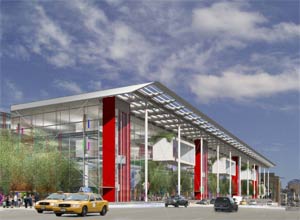Frank Gehry has one, so do Jean Nouvel and Norman Foster. Renzo Piano has two. But last month, when New York’s governor scrapped a convention center expansion project, Richard Rogers—who joined Piano in electrifying Paris with the Pompidou Center during the early 1970s—remained a Pritzker Prize winner who has worked in New York City without a finished project to show for it.

Richard Rogers’ design for an expansion of the Jacob K. Javits Convention Center, on Manhattan’s far West Side, which New York Governor Eliot Spitzer scrapped in January in favor of a smaller scheme.
Image courtesy Empire State Development Corporation
The project was an expansion of I.M. Pei’s 1986 Jacob K. Javits Convention Center, nearly doubling its 790,000 square feet of exhibition space and creating a waterfront promenade along the Hudson River. Since Rogers’ scheme was unveiled in 2006, though, estimated construction costs ballooned twofold to $3.2 billion—prompting Governor Eliot Spitzer to cancel the project on January 31 in favor of a more modest 100,000-square-foot addition that will stay within the original budget.
The Javits expansion was one of three long-gestating developments that would have brought Rogers’ grand waterfront promenades to the Big Apple’s skuzzy edges. In 2005, he co-led a study for a city-sponsored project to liven downtown Manhattan’s South Street waterfront under an elevated highway on the East River. And in 2006, the city approved his design for residences, retail, and film production facilities at Silvercup Studios on the river’s opposite bank, in Queens.
All three waterfront projects could still happen—some day, in some form. At Javits, Rogers and FXFowle will remain at work on the smaller expansion under an amended contract, says Empire State Development Corporation spokesperson Warner Johnston. At South Street, meanwhile, Rogers decided against bidding to work on the actual design of the $150 million project, which local partner SHoP Architects and Ken Smith Landscape Architects are executing this year. “I don’t think it was a very large project for them,” SHoP partner Gregg Pasquarelli observes.
Despite delays, Silvercup Studios is still championing Rogers’ plan for a new district called Silvercup West. It includes restores the landmark 1892 New York Architectural Terra Cotta Company building and converting it into a soundstage, then surrounding the structure with three towers containing 1,000 apartments, offices, and a retail-rich esplanade. Proponents of the 2-million-square-foot, $1 billion project had initially hoped that construction would begin this year. But Silvercup CEO Alan Suna says that it’s taken a year longer than expected to secure permission to enter the site and test the soil at an old power plant that Silvercup intends to demolish.
Should Rogers feel accursed? Not necessarily. Pasquarelli says that fits and starts come with the territory for anyone who works at such a large scale. “That’s the nature of design at the highest level. A lot of projects don’t move forward. You only notice because Rogers is at such a high caliber and everyone was excited about what he was going to do.”
If anything, demand for work by Rogers and other high-profile international architects remains strong, adds Foster + Partners’ Michael Wurzel. “People really appreciate the fact that architects from around the world are working in the city,” he says. “I think there’s a sense of a new skyline.”
To that end, Rogers may get his own gleaming tower before any of his waterfront esplanades open: he is one of three architects, along with Foster and Fumihiko Mahi, who have designed towers for the World Trade Center site. Developer Larry Silverstein has promised that excavation work on the towers will begin within weeks, keeping pace for a 2012 opening.



Post a comment to this article
Report Abusive Comment